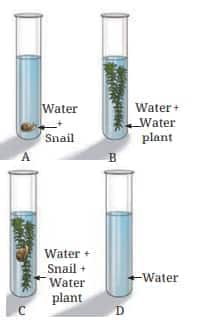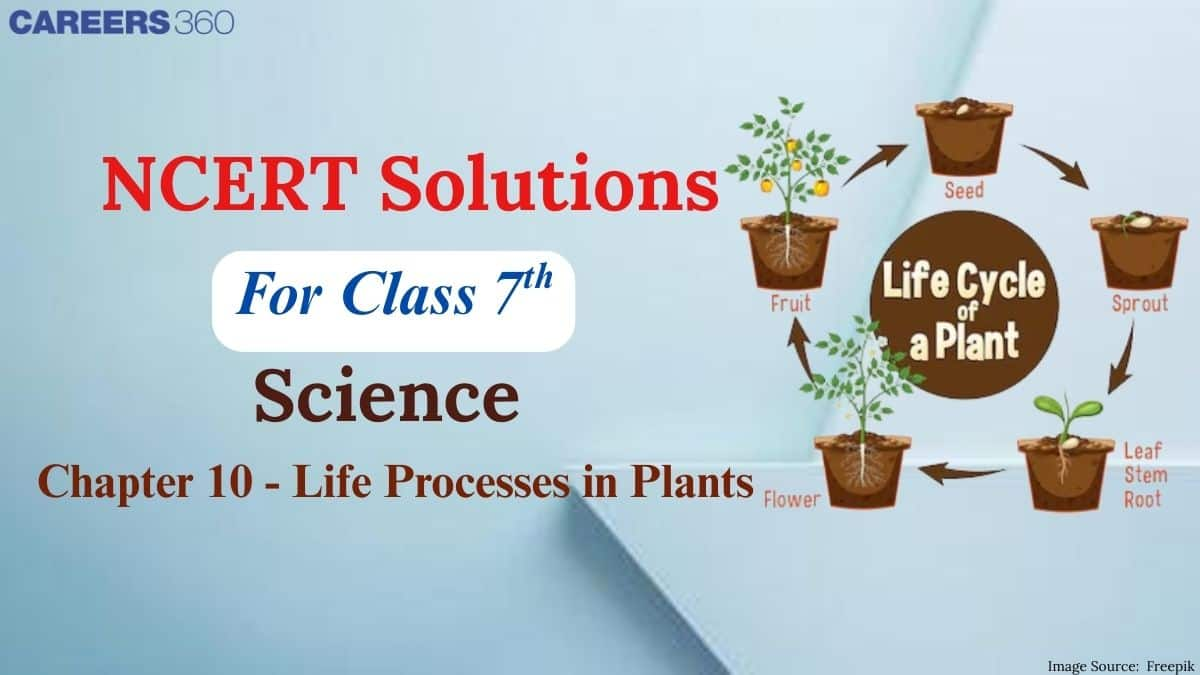Access Class 7 Science Chapter 10 Life Processes in Plants Question Answer
The solved exercise questions of the chapter Life Processes in Plants are given below. Continuous practice of the Class 7 Science Chapter 10 Life Processes in Plants question answers improves understanding of plants.
Question 1: Complete the following table
S.No. | Feature | Photosynthesis | Respiration |
1. | Raw materials |
|
|
2. | Products |
|
|
3. | Word equation |
|
|
4. | Importance |
|
|
Answer:
The completed table is given below:
S.No. | Feature | Photosynthesis | Respiration |
1. | Raw materials | Carbon dioxide, water, and sunlight | Glucose, oxygen |
2. | Products | Glucose, oxygen | Carbon dioxide, water, energy (ATP) |
3. | Word equation | Carbon dioxide + Water → Glucose + Oxygen (in the presence of sunlight) | Glucose + Oxygen → Carbon dioxide + Water + Energy |
4. | Importance | Produces food and oxygen, the foundation of the food chain | Provides energy for the growth and development of all living beings |
Question 2: Imagine a situation where all the organisms that carry out photosynthesis on the Earth have disappeared. What would be the impact of this on living organisms?
Answer: If photosynthesizing organisms disappear, there will be no food and oxygen for animals and humans. Plants make food and oxygen through photosynthesis, which supports all life on Earth. Without it, animals and humans would starve and have no air to breathe. The balance of oxygen and carbon dioxide in nature would break, leading to the extinction of almost all living organisms.
Question 3: A potato slice shows the presence of starch with iodine solution. Where does the starch in potatoes come from? Where is the food synthesised in the plant, and how does it reach the potato?
Answer: Starch in potatoes comes from the food prepared in the leaves. Leaves make glucose by photosynthesis, which is carried through phloem tubes to different parts of the plant. This food reaches the underground stem, the potato, where it is stored in the form of starch. The iodine test turns blue-black because of the presence of this starch inside the potato cells.
Question 4: Does the broad and flat structure of leaves make plants more efficient for photosynthesis? Justify your answer.
Answer: Yes, broad and flat leaves help plants capture more sunlight. A bigger surface area means the leaf can absorb more sunlight and carbon dioxide, both of which are needed for photosynthesis. More light and air allow the plant to make more food quickly. This helps the plant grow better and stay healthy. So, such a structure makes the process of photosynthesis more efficient.
Question 5: X is broken down using Y to release carbon dioxide, Z, and energy.
X + Y Carbon dioxide + Z + Energy
X, Y, and Z are three different components of the process. What do X, Y, and Z stand for?
Answer: In the equation:
X = Glucose, Y = Oxygen, Z = Water
The process shown is respiration. During respiration, glucose is broken down with the help of oxygen to release carbon dioxide, water, and energy. This energy is used by the plant for growth and other activities. This shows how plants get energy from the food they make through photosynthesis.
Question 6: Krishna set up an experiment with two potted plants of the same size and placed one of them in sunlight and the other in a dark room, as shown in the Figure.
Answer the following questions-
(i) What idea might she be testing through this experiment?
(ii) What are the visible differences in plants in both conditions?
(iii) According to you, leaves of which plants confirm the iodine test for the presence of starch?

Answer:
(i) Krishna is testing whether sunlight is needed for photosynthesis.
(ii) The plant in sunlight will look green and healthy, while the plant in the dark will look weak and pale.
(iii) The leaves of the plant kept in sunlight will turn blue-black with iodine, showing that starch is made. The dark-room plant will not show starch.
Question 7: Vani believes that ‘carbon dioxide is essential for photosynthesis’. She puts an experimental setup, as shown in the Figure, to collect evidence to support or reject her idea.
Answer the following questions -
(i) In which plant(s) in the above set-up(s) will starch be formed?
(ii) In which plant(s) in the above set-up(s) will starch not be formed?
(iii) In which plant(s) in the above set-up(s) will oxygen be generated?
(iv) In which plant(s) in the above set-up(s) will oxygen not be generated?

Answer:
(i) Starch will be formed in the plant kept in sunlight with carbon dioxide.
(ii) It will not be formed in plants without sunlight or without carbon dioxide.
(iii) Oxygen will be produced in the plant exposed to both sunlight and carbon dioxide.
(iv) Oxygen will not be made in plants without light or carbon dioxide. This proves carbon dioxide is needed for photosynthesis.
Question 8: Ananya took four test tubes and filled three-fourths of each test tube with water. She labelled them A, B, C, and D. In test tube A, she kept a snail; in test tube B, she kept a water plant; in test tube C, she kept both a snail and a plant. In test tube D, she kept only water. Ananya added a carbon dioxide indicator to all the test tubes. She recorded the initial colour of water and observed if there were any color changes in the test tubes after 2–3 hours. What do you think she wants to find out? How will she know if she is correct?

Answer: Ananya wants to find out how plants and animals change the amount of carbon dioxide in water. If only the snail is present, carbon dioxide increases. If the plant is present, it uses the carbon dioxide. She will check the color change of the indicator to know if carbon dioxide was added or removed in each test tube. This helps her understand gas exchange.
Question 9: Design an experiment to observe if water transportation in plants is quicker in warm or cold conditions.
Answer: Take two plants of the same size. Place one in a warm place and the other in a cool place. Add coloured water to both pots. After some time, cut the stem and see how far the color has moved up. The plant in the warm place will show more color, which means water moves faster in warm conditions. This proves that temperature affects water transport.
Question 10: Photosynthesis and respiration are essential to maintain balance in nature. Discuss.
Answer: Photosynthesis and respiration keep nature in balance. Plants take in carbon dioxide and give out oxygen during photosynthesis. Animals and humans use this oxygen and give out carbon dioxide during respiration. The carbon dioxide is again used by plants. This cycle helps keep the right amount of gases in the air and provides food and energy for all living things to survive.
Important Questions from Class 7 Science NCERT Chapter 10 Life Processes in Plants
The chapter "Life Processes in Plants" explains how plants make their food through photosynthesis. Given below is a question along with the answer. To boost confidence, students can solve more questions using the NCERT Solutions for Class 7 Science Chapter 10 Life Processes in Plants, which follows the latest NCERT guidelines.
Question 1: Which structure in plant leaves is mainly responsible for the exchange of gases during photosynthesis?
a) Xylem
b) Phloem
c) Stomata
d) Cuticle
Answer: The correct answer is option c) Stomata
Explanation:
Stomata are tiny pores found mostly on the underside of leaves. They play a crucial role in the exchange of gases, allowing carbon dioxide to enter the leaf and oxygen to exit during photosynthesis. Stomata also help in transpiration, which is the loss of water vapor from the plant. The opening and closing of stomata are vital for maintaining the plant’s water balance and enabling efficient photosynthesis.
Question 2: Which of the following is important for photosynthesis in plants?
a) Sunlight
b) Carbon dioxide
c) Water
d) All of the above
Answer: The correct answer is option d) All of the above
Explanation:
Photosynthesis is the process by which plants make their own food using sunlight, carbon dioxide, and water. Chlorophyll in the leaves captures sunlight to produce glucose and oxygen.
Question 3: What is the main role of leaves in a plant?
a) To store water
b) To make food through photosynthesis
c) To absorb minerals from the soil
d) To support the plant
Answer: The correct answer is option b) To make food through photosynthesis
Explanation:
Leaves are the primary sites of photosynthesis in plants. They contain chlorophyll, which captures sunlight to produce food, providing energy for the plant’s growth and survival.
Question 4: Why do we decolorize a leaf at the beginning of the starch test experiment?
a) To make the leaf soft
b) To easily observe color change and detect the presence of starch
c) To remove water from the leaf
d) To increase photosynthesis
Answer: The correct answer is option b) To easily observe color change and detect the presence of starch
Explanation:
Decolorization of a leaf enables us to easily observe color change and, thus, the presence of starch. This clearly shows the presence of starch produced during photosynthesis.
Question 5: Which gas from the air is important in the process of food preparation in plants?
a) Oxygen
b) Hydrogen
c) Carbon Dioxide
d) Nitrogen
Answer: The correct answer is option c) Carbon Dioxide
Explanation:
Plants use carbon dioxide from the air during photosynthesis to make food. In the presence of sunlight and chlorophyll, carbon dioxide and water are converted into glucose and oxygen, which provide energy for the plant to grow.
Question 6: Which tissues help in the transport of water and food in plants?
a) Xylem and Phloem
b) Stomata and Cuticle
c) Roots and Flowers
d) Chlorophyll and Vacuole
Answer: The correct answer is option a) Xylem and Phloem
Explanation:
Xylem transports water and minerals from the roots to all parts of the plant, while phloem carries prepared food from the leaves to the rest of the plant. Together, they form the vascular system of plants.
Question 7: What is transpiration in plants?
a) Making food using sunlight
b) Loss of water vapor through stomata
c) Transport of food in phloem
d) Absorption of minerals from the soil
Answer: The correct answer is option b) Loss of water vapor through stomata
Explanation:
Transpiration is the process through which plants lose water vapor from their leaves, mainly through stomata. This process helps in cooling the plant and also creates a suction force that helps pull water upward from the roots.




